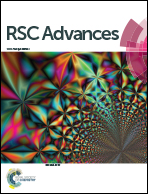Sodium alginate-assisted photosynthesis of complex silver microarchitectures†
Abstract
Flower-like, complex, polycrystalline silver microarchitectures were synthesized in the presence of sodium alginate, facilitated by the oriental adherence of polysaccharides under natural light. These 3D microarchitectures displayed unique SPR absorption as well as significant Raman scattering activity.


 Please wait while we load your content...
Please wait while we load your content...